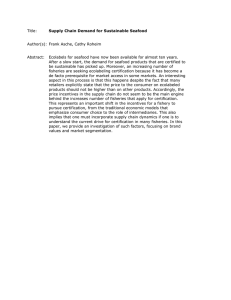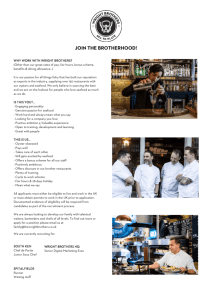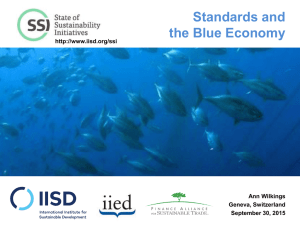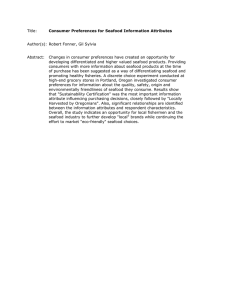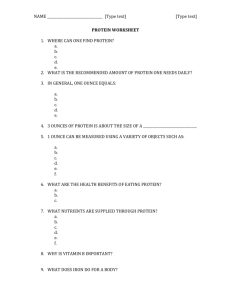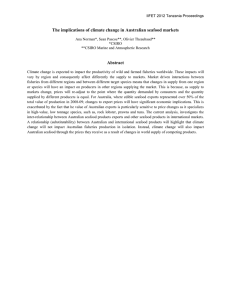Document 14625849
advertisement
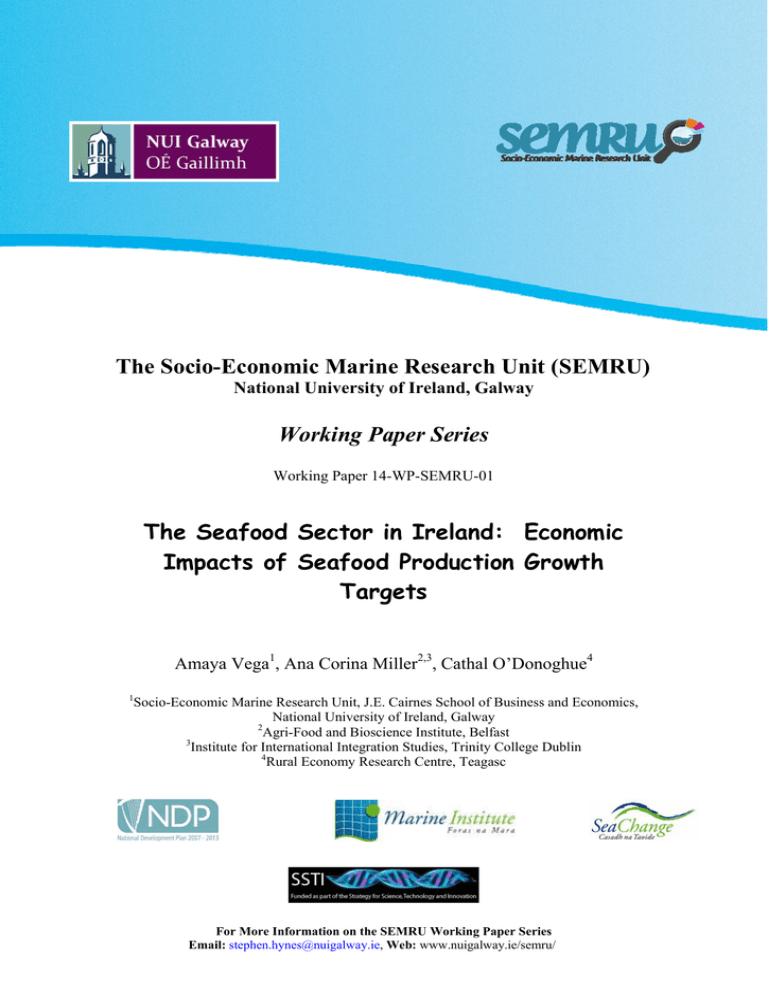
14-WP-SEMRU-01 The Socio-Economic Marine Research Unit (SEMRU) National University of Ireland, Galway Working Paper Series Working Paper 14-WP-SEMRU-01 The Seafood Sector in Ireland: Economic Impacts of Seafood Production Growth Targets Amaya Vega1, Ana Corina Miller2,3, Cathal O’Donoghue4 1 Socio-Economic Marine Research Unit, J.E. Cairnes School of Business and Economics, National University of Ireland, Galway 2 Agri-Food and Bioscience Institute, Belfast 3 Institute for International Integration Studies, Trinity College Dublin 4 Rural Economy Research Centre, Teagasc For More Information on the SEMRU Working Paper Series Email: stephen.hynes@nuigalway.ie, Web: www.nuigalway.ie/semru/ 14-WP-SEMRU-01 SEMRU Working Paper Series The Seafood Sector in Ireland: Economic Impacts of Seafood Production Growth Targets Amaya Vega, Ana Corina Miller, Cathal O’Donoghue Abstract This paper examines the potential economic impact of the Irish government strategy for the development of the seafood sector in Ireland, Food Harvest 2020 (FH2020). The seafood industry accounts for a large proportion of income and employment in peripheral coastal areas. Many of these regions are predominantly rural and they are largely dependent on the primary fisheries sector. Moreover, the services and retail businesses in these areas are heavily dependent on direct spending from the fisheries, aquaculture and seafood processing sectors. A social accounting matrix (SAM) approach with (1) set to zero purchase coefficients for all directly impacted industries and (2) changes in output converted to final demand shocks is used to calculate the economic and employment impact on the rest of the economy from an increase in the output in the fisheries, aquaculture and seafood processing sectors in Ireland. The results suggest fisheries sectors have strong links with the rest of the economy hence an important economic impact from a policy perspective. Keywords: Economic impact, social accounting matrix, Irish seafood sector, employment multiplier This work was funded through the Beaufort Marine Research Award, which is carried out under the Sea Change Strategy and the Strategy for Science Technology and Innovation (2006-2013), with the support of the Marine Institute, funded under the Marine Research Sub-Programme of the National Development Plan 2007–2013. Author Contact Details: Amaya Vega, SEMRU, NUI Galway – Amaya.vega@nuigalway.ie 14-WP-SEMRU-01 1. Introduction The Irish seafood sector is a complex and fragmented traditional indigenous industry that makes a significant contribution to the national economy in terms of output, employment and exports. The industry contributed €242 million in Gross Added Value (GVA) to the Irish economy in 2010 [1]. While its contribution to the national economy is small relative to the agri-food sector, the Irish seafood sector is of strategic importance for the sustainable development of coastal communities. The spatial distribution of the sector, mainly dispersed along the Irish coastline, provides it with a key role in sustaining remote coastal areas through the generation of income and jobs. This paper contributes to the broad area of marine strategic planning in the context of the promotion and development of the seafood sector. The overall aim of the research is to present the structure and linkages of the Irish seafood sector with the rest of the economy as a strategic planning tool to facilitate the decision-making process involved in implementing the Irish government’s strategy for the medium-term development of the seafood industry. Recent policy developments at the national level show the government’s recognition of the importance of the seafood sector in Ireland. Based on the prospects of a strong increase in market demand for seafood at the global and European level, Food Harvest 2020 (FH2020) strategy [2] aims to raise the sector’s annual sales to €1 billion, to increase employment to 14,000 full-time equivalent jobs and to expand aquaculture production by 78 percent by 2020. The extent to which these targets could have an impact on the economy as a whole is the subject of this paper. The objective of the current study is to assess the economic impact of the FH2020 seafood growth targets as well as the job creation potential. This assessment includes not only the direct effect on employment, but also the knock on effect that an increase in economic activity in the seafood sector would have on the rest of the economy. This is what is commonly known as the (indirect and induced) multiplier effect. This paper examines the employment multiplier effect from the projected increase in activity in the fisheries, aquaculture and seafood processing sectors using an Agri-Food Social Accounting Matrix (SAM) model for Ireland. The Irish seafood sector consists of a commercial fishing sector, an aquaculture sector and a seafood processing sector. The commercial fishing sector involves pelagic, demersal and shellfish fisheries with 2,247 registered fishing vessels and a combined gross tonnage of 65.2 thousand GT in 2012 [3]. There are six primary landing ports in Ireland - Killybegs, Castletownbere, Rossaveal, Howth, Dunmore East and An Daingean - and over one hundred secondary ports, piers and landing places. The total employment for the fishing sector in Ireland was estimated at 4,714 jobs in 2011 [3]. The aquaculture sector includes finfish and shellfish farming enterprises distributed across 2,000 sites. Aquaculture production in 2010 was 46,600 tonnes with an overall value of 122.5 million Euros in 2010. The number of people employed in the Irish aquaculture sector was 1,719 persons [4]. According to the latest STECF reports on the EU fishing fleet and the aquaculture sector, aquaculture production in Ireland accounts for approximately 13 percent of total Irish seafood production in 2010. 14-WP-SEMRU-01 Recent disease and parasitic infestation together with a low market demand in the organic salmon sector are likely to bring the production growth in the Irish finfish sector to a standstill in 2013 [4]. The Irish seafood processing sector is comprised of approximately 200 seafood processing companies. These are mostly small enterprises-less than 10 employeesand they are primarily located in coastal communities, which greatly depend on this industry for employment [5]. The total employment for the seafood processing sector in Ireland was 1,586 in 2010 [1]. While the economic downturn has had an impact on employment, the value of exports has increased in the recent years with a total market value of €517 million Euros in 2012, which represents an increase of over 20 percent with respect to 2011 [6]. The primary export market for Ireland is France with a market share of 22 percent in 2012 followed by Great Britain and Spain, with market shares of 15 percent and 10 percent respectively [6]. On the consumption side, seafood per capita consumption in Ireland has experienced considerable growth in the last few years and it is estimated at 21.4 kg per annum. While this is still below the EU average of 22.1 kg per capita consumption, it represents a home market value of 329 million Euros [6]. The European policy context affecting the seafood sector is extensive. Production of wild fish is regulated at national and EU levels. The Common Fisheries Policy (CFP), formally introduced in 1983, is the European Union’s instrument for the management of fisheries. Aimed at enhancing the sustainability of fish stocks and the economic competitiveness of the fishing industry [7], it has been recently subject to reform. One of the most important areas of action of the common fisheries policy is setting the EU fishing rules. Ireland receives roughly one fifth of the total allowable catch set by the EU for Western Waters area. In this paper, a social accounting matrix (SAM) for the agri-food sector in Ireland is used to estimate the economic and employment impact of the seafood sector production growth targets in FH2020. A SAM is a step above a standard input-output transaction table in terms of its ability to characterise the linkages that take place in an economy. An input-output table shows the link between production accounts, factors of production, private and public expenditure, investment, imports and exports, while a SAM can be interpreted as the representation of the circular flow production-income-expenditure-production. A SAM contains information on the owners of the factors (households, enterprises, government) and foreign accounts transactions, while in the input-output table there is no information on those transactions, since it excludes the distribution of income in the economy [8]. The main advantage of a SAM based-analysis over the input-output analysis is that interindustry linkages are taken into account as well as other transactions that are important for coastal communities [9]. There are numerous examples of the use of social accounting matrix (SAM) models in the context of fisheries management. Fernández-Macho, Gallastegui [10] and Seung and Waters [11] applied a SAM model to assess the contribution of the fishery sector on output, employment, and income. Seung and Waters [11] used a mixed 14-WP-SEMRU-01 endogenous-exogenous model to investigate the impacts of reduction in pollock TAC for North Pacific fisheries using a SAM framework. More recently, Seung and Waters [12] use an adjusted Alaska SAM model to estimate the economic impact of exogenous changes in output as part of recent fisheries management actions and Arita, Pan and Leung [13] use SAM modelling to assess the income distribution linkages of Hawaii’s commercial fishery sector. The calculation of input-output multipliers to capture the direct and indirect effects of changes in final demand began in Ireland with the early work of Copeland and Henry [14]. Multiplier analysis has been widely applied to assess the economic importance of particular industries (for example, agri-food sector: Miller et al.[15]; tourism: Norton [16]; O’Hagan and Mooney [17]; marine sector: Morrissey and O’Donoghue [18], or energy sector: Clancy and Scheer [19]. Indeed, the widespread use of multipliers to expand our understanding of the economic importance of a sector in consultancy studies and by lobby groups seeking to stress the importance of their industry to the economy and to justify receiving special incentives, has brought multiplier analysis into a state of disrepute. During the brief period of full employment in the Irish economy in the mid-2000s the assumption of unemployed resources necessary to justify the use of multiplier estimates to influence investment allocation clearly did not apply. The disrepute attached to multiplier analysis is only partially justified, however. Multiplier estimates properly interpreted can give important insights into the structure of the economy and the ’embeddedness’ of different sectors. They are also useful in helping to trace the total impacts of changes in the structure of the economy. For example, O’Doherty and Tol [20] developed an environmental input-output model to estimate the short-run response of emissions and resource use to changes in consumption and production patterns in Ireland. The rest of the paper is organised as follows. Section 2 described the conceptual approach to defining the policy scenarios. Section 3 presents the methodology and data sources. Section 4 discusses the results and section 5 concludes. 2. The seafood sector in Ireland The Irish seafood sector consists of a commercial fishing sector, an aquaculture sector and a seafood processing sector. Tables 1 and 2 show the most recent trends in Irish fishing and aquaculture since 2008. Employment in the fishing sector has increased significantly in the 2009-2011 period, most likely as a result of the economic recession and the drop in activity in the construction sector in Ireland. From a European perspective, Ireland ranks eighth with regard to its contribution to the overall value added of sea fisheries among the 27 member states. Table 2 shows recent trends in the Irish aquaculture sector for the 2008-2010 period. While production volumes have remained stable, there has been a large growth in turnover and in value added, with increases of 30 percent and over 70 percent respectively. [Insert Table 1] [Insert Table 2] 14-WP-SEMRU-01 Regarding international trade, exports of Irish seafood are on the rise. According to the Irish Sea Fisheries Board, exports increased 20 percent in value in 2012, representing 60 percent of the total value of the sector [6]. This is supported by a significant growth in the global seafood market driven by an increase in the consumption of seafood in Asia. The global per capita consumption of seafood has been increasing steadily worldwide [21]. According to the Food and Agriculture Organization for the United Nations (FAO), Asia accounts for two-thirds of the total consumption of seafood with 85.4 million tonnes (20.7 kg per capita). China is responsible for most of the increase in the world per capita seafood consumption with 31.0 kg in 2009. The corresponding per capita consumption in North America and Europe is 24.1 kg and 22.0 kg respectively [21]. World imports of seafood and seafood products have increased by 86 percent in the period 2000-2010 [21]. While the United States of America and Japan are still the main importers of fish, China, the world’s largest fish producer and exporter, has also increased its imports of seafood. This is not only due to an increase in domestic demand, but also a result of outsourcing. Chinese seafood processors are increasingly importing from other regions, including Europe, and re-processing for exporting [21]. 2.1 Policy context and scenarios At the national level, Food Harvest 2020 strategy’s (FH2020) [2] targets are a mixture of volume and value growth targets for the agricultural, fisheries and forestry sector achievable by 2020. The overall targets are translated into: (i) an increase in the value of primary output in the agriculture, fisheries and forestry sectors by €1.5 billion, representing a 33 percent increase compared to the 2007-2009 average; (ii) an increase in the value-added in the agriculture and food, fisheries and wood products sector by €3 billion, a 40 percent increase compared to 2008; and (iii) an increase in exports of €12 billion for the sector, a 42 percent increase compared to the 2007-2009 average. In this paper, the economic impacts of the seafood production growth targets outlined in FH2020 are estimated. The production growth targets for the seafood sector in FH2020 are as follows: (i) a 78 per cent increase in aquaculture volume production based on the 2007-2009 aquaculture production average, (ii) an increase from €700 million to €1billion in revenue and (iii) an increase in employment to 14,000 full-time equivalent jobs by 2020 in sea fisheries and aquaculture sectors. The FH2020 strategy targets the output level in the seafood sector. In the context of a sectoral analysis, a supply-driven SAM multiplier approach is used to assess the impact of the production growth targets. Two scenarios are drawn from the FH2020 strategy: (i) Scenario 1: 78 percent increase in aquaculture volume, using the 20072009 average is equivalent to 36.6 tonnes increase in aquaculture production. Using 2005 prices and volume data as a base (SAM base year) a value increase of 80 million euro in the output of the seafood primary sector is estimated. (ii) Scenario 2: increase in sales from €700 million (average of 2007-2009) to €1 billion. Again, using 2005 as a base year and the output/sales ratio for that year - in total of 810 million - results in an increase of €190 million from the base year. The assumption regarding the distribution of this €190 million between primary seafood and seafood processing sector is made on the shares of the output in 2005, (i.e. primary seafood €450 million and seafood processing €360 million). Hence, an increase of €106 million in the 14-WP-SEMRU-01 output of primary seafood sector and an increase of €84 million in the output of the seafood processing sector are estimated. In the classic SAM multiplier analysis the exogenous shock come from a change in final demand. In this instance, the FH2020 strategy targets the sectoral output and therefore, an augmented approach is used. A brief discussion of the approach used is provided in the next section. 3. Methodology and Data The paper examines the economic impact of the Food Harvest 2020 seafood production growth targets. This exercise employs a social accounting matrix model using a 2005 AgriFood-SAM for Ireland to provide information on the backward and forward linkages of the fishery sector with the rest of the sectors in the economy as well as calculates the direct, indirect and induced impact on employment of an exogenous shock. 3.1 The structure of the 2005 AgriFood-SAM model for Ireland The Social Accounting Matrix (SAM) used in this paper is described in Miller et al. [8] and adapted for fish harvesting and fish processing industries. A SAM is a square balanced matrix that portrays the economic flows from one account to another, representing expenditures and receipts of all the economic agents in the economy, with the condition that total expenditure and total receipts of each agent are equal. The 2005 AgriFood-SAM for Ireland is an extension of the Input-Output Table published by the Central Statistics Office of Ireland (CSO) in 2009 [22]. It is a 180x180 Social Accounting Matrix, with 75 activities producing 75 commodities, 3 factors of production (labour, capital and land), 11 institutions (9 farm and non-farm households, enterprises and government), 11 tax-related accounts (direct, indirect tax and custom duties, subsidies, etc), one savings/investments account, one changes in stock account and 3 external accounts (UK, REU and ROW). The agri-food sector is represented by 12 primary agriculture sectors producing 12 agriculture commodities, one fish and one forestry sector and 10 food processing sectors producing 10 food commodities including fish processing sector, providing great detail about the downstream activities of the food system and its relationship with the agricultural sectors. A detailed discussion of the SAM is presented in Miller et al.[8]. 3.2 Methodology Table 1 shows a simplified macro SAM with four types of accounts: production activities, factors of production, institutions (households and enterprises) and one exogenous account. To trace out and analyse the linkages within the economy, the model assumes that all equations are linear, prices are fixed and all production activities function under the condition of excess demand, following Pyatt and Round [23]. A SAM-based model assumes that one or more accounts are made exogenous to allow the changes in the exogenous accounts be translated into changes in other sector’s supply. The model becomes a demand-driven Keynesian model with no resource constraints. The exogenous accounts are aggregated into a single account which records the injections into the system and the leakages from it. The leakages include transfer income sent to the rest of the world, institutional savings, indirect taxes and imports, while the injections include transfers from the rest of the world, 14-WP-SEMRU-01 government transfers to institutions, government consumption and export demand. The exogenous account can be seen as an independent variable while the endogenous account is the dependent variable. The choice of which transactions and transfers are to be considered endogenous and/or exogenous depends on the policy question. In general the government account, the rest of the world account, the capital account and the account for indirect taxes are regarded as exogenous accounts, and the remaining accounts are viewed as endogenous. [Insert Table 3] is the matrix of intermediate inputs needed; is the matrix of consumption expenditure of institutions; is the value added (labour and capital) matrix is the income distribution matrix between institutions; and generated by activities; is the matrix of transfers between institutions. The revenue or income of the endogenous accounts is represented by and , which are the production activities, factors of production and institutions revenue, respectively. The sum of the exogenous injections is consolidated into one vector and represents the corresponding leakages. The matrix of direct coefficients is obtained by dividing each element in any of the endogenous accounts by its total income (column total). (1) Following Adelman and Robinson [24] and Miller and Blair [25], the matrix of direct coefficients in a demand-driven SAM is given by (2) Where A is the matrix of intra-industries technical coefficients, sales and purchases; V is the matrix of value added coefficients, payments from production accounts to factors; Y is the matrix of value added distribution coefficients, factor payments to other institutions; C is the matrix of expenditure coefficients, household purchases of industry output; and H is the matrix of institutional and household distributional coefficients, inter-household and/institution transfers. The demand system of equations is given by: (3) Where x, v and y are the vectors of total production, total value added and total institutional income, respectively; are the vectors of exogenous good and services demand and household transfer payments. The demand-driven multipliers are obtained using the following equation: (4) 14-WP-SEMRU-01 This system of equations can be used to calculate the multiplier effect from an exogenous increase in demand (arising say from an increase in fish products exports). However, the model in its present form is not suitable for the evaluation of a policy such as an exogenous increase in output (i.e. a 78 percent increase in the volume of aquaculture production). Leung and Pooley [26] proposed a Leontief supply-driven model to assess the impacts of a reduction in output of a single sector, the Hawaii longline fishery. Following their research, Cai and Leung [27] suggest an alternative set of backwardlinkages and forward-linkages measures “more refined than their existing counterparts” assuming the “shocks directly on output rather than on final demands”. They propose the use of Leontief supply-driven multipliers backward-linkage (LSDBL) measure and Ghosh [28] supply-driven multipliers forward-linkage (GSD-FL) measure when shocks are directly applied on outputs. Miller and Blair [25] provides a detailed description of the supply-driven approach to measure the linkage impact on sectors or commodities. Seung and Waters [11] and Fernandez-Macho et al. [10] use a similar model, a mixed endogenous-exogenous model, to assess the backward and forward linkages for Alaska fisheries and Galician fishing sector, respectively, when shocks are directly applied on outputs. These models all use the Ghosh approach, to calculate forward linkages effects, which is still controversial despite the considerable research [29, 30]1 . Tanjuakio et al. [31] and Steinback [32] propose a Leontief demand-driven Input– Output model while assuming zero regional purchase coefficients (RPC) for the directly impacted industries and converting the changes in output into final demand shocks. The authors argue that this approach eliminates the overestimation bias introduced by the assumption that a change in output can be modelled as a change in final demand using a demand-driven model and overcomes Ghosh approach weakness in estimating the economic impact of an exogenous change in sectoral output. Recently, Seung and Waters [12] used a SAM demand-driven model with zero RPC for directly impacted industries to assess the economic impact of a shift in harvesting opportunities due to the Steller sea lion protection measures. Following Seung and Waters [12], this paper focus on calculation the economic impact and the employment multiplier effect of the projected increase in activity in the fisheries, aquaculture and seafood processing sectors using an AgriFood Social Accounting Matrix (SAM) model for Ireland. 4. Impact of the seafood production growth target on the Irish economy This section discus the economic impact of the Irish seafood primary and seafood processing sectors on the rest of the sectors of the economy and the employment impact of the two scenarios defined in Section 3. The direct employment coefficients are calculated as the ratio of employment to output for each individual sector in the social accounting matrix. The base year for the 1 The theoretical interpretation of the Ghosh methodology has been highly criticized, particularly when used to explain ‘physical’ output changes due to ‘physical’ changes in primary factor of production inputs (i.e. labour, capital) and should be keep in mind when interpreting the results (Oosterhaven (1988), Oosterhaven, 1989). 14-WP-SEMRU-01 SAM for Ireland is 2005 and the FH2020 base period for the simulated shocks is the average level of production between 2007 and 2009. The Census of Industrial Production, 2008 [33] data are used to obtain more up-to-date employment coefficients based on the number of employees and output in the food processing sectors for 2008. For the agricultural sectors the Annual Review and Outlook for Agriculture, Fisheries and Food and the Management Data for Farm Planning [34] are used to allocate the 2008 employment numbers between the 12 agricultural sectors. The method used is the same one used in the construction of the 2005 AgriFood-SAM described in Miller et al. [8]. Tables 4, 5a and 5b present the output multipliers for selected activities for Scenario 1 and Scenario 2, respectively. In the case of Table 4, - Scenario 1- the 78 per cent increase in the volume of aquaculture production leads to a possible total output impact of the proposed increase of €164,320 million in all the Irish economic activity. This is not surprising as the interaction between the seafood sector as an input demander and the rest of the economy is quite important. The most significant impacts are from sectors that provide most of the intermediate inputs such as, business services, including legal, accounting and auditing activities, petroleum and other sectors, mainly due to fuel purchases included in the other sectors and food processing, but also through the indirect impacts generated by the circular flow of the economy in sectors such as the hotel and restaurants, insurance, pension funding and financial intermediation services. [Insert Table 4] The multipliers for Scenario 2 are shown in Tables 5a and 5b. In Table 5a, the multipliers are identical to those in Table 4 as the exogenous shock is on the output of primary seafood production. The strong backward link between the primary seafood sector and the rest of the sectors in the economy is evident once again. The total output impact adds up to €217,724 million. [Insert Table 5a] [Insert Table 5b] Table 5b presents the multipliers as well as the economic impact of an increase in seafood processing output (i.e. fish commodities). An increase in the seafood processing sector output could bring an increase in total output of €159,034 million. The highest direct backward linkage of this sector is with the business services sector followed by the petroleum and other manufacturing sectors and the food processing sector. The output multipliers are also used to calculate the impacts on employment. The economic impact on employment for each sector as an effect of an increase in seafood output are shown in Tables 6 and Table 7 for Scenario 1 and 2, respectively. In both tables, the estimated impacts on employment offer a strong relationship between the seafood sector and the rest of the economy. Table 6 shows that the total employment impact of a 78 per cent increase in the production volume from aquaculture would result in an increase in 828 equivalent jobs, with the largest impacts on the business services and hotel and restaurants sectors. 14-WP-SEMRU-01 [Insert Table 6] Table 7 shows that the largest impact on employment of 1,097 equivalent jobs comes from the increase in the output of the primary seafood sector, while an increase in the output of the seafood processing sector would result in an increase in 874 jobs. [Insert Table 7] In this paper, an augmented demand-driven SAM multiplier approach is used to assess the output growth targets of the seafood production sector on the wider economy. The model used in this paper, which follows Seung and Waters [12] approach, sets to zero the purchase coefficients for all directly impacted sectors, in order to overcome the double counting typically encountered when a demand–driven approach is used to estimate the effects of an exogenous change in output. Also, the output changes are treated as final demand shocks. As demonstrated by Miller and Blair [25] using a 3 by 3 matrix example, the mixed endogenous-exogenous method gives the same results as the approach used in this paper.2 5. Summary and conclusions Economic activities directly related to the seafood industry are spatially concentrated along the Irish coastline and in particular in remote coastal areas. Most of these peripheral regions have been disproportionally affected by the recent economic downturn, experiencing high unemployment levels and increasing migration as a result. The essential role of the seafood sector in sustaining coastal communities through the generation of income and jobs has been recognised by the Irish government in recent marine policy documents. This study presents a contribution to the broad area of strategic planning for the marine sector. A SAM model is used as a management tool to guide the systematic process of acquisition and allocation of resources needed to achieve essential priorities for marine policy. In this particular case, the focus is on the assessment of the potential economic and employment impacts of the Irish government’s seafood production growth strategy (FH2020). This assessment includes not only the potential direct effect, but also the estimated knock-on effect that an increase in economic activity in the seafood sector would have on the rest of the economy and on employment. Europe’s strategy priorities for 2020 of a smart, sustainable and inclusive economy and the strong emphasis on job creation highlight the potential benefits from using strategic management tools such as a SAM model for the assessment of the direct and induced socio-economic impacts of specific policy targets. In the context of Irish marine policy, the recently published strategy by the Irish Sea Fisheries Board [35] states the need to move from commodity trading into added value seafood products as a key element for growth in the seafood sector in Ireland. The Irish government is committed to continuing investing in the promotion of a more integrated seafood industry to support job creation and greater economic activity in the seafood processing sector [35]. On this regard, assessing the potential socio-economic impact 2 Complete results from both methods are available from the authors on request. 14-WP-SEMRU-01 of these investments is crucial for achieving efficiency in the entire strategic planning process. Overall, the empirical results obtained in this study show the existence of important economic impacts, which confirms the strong interaction between the seafood sector as an input demander and the rest of the economy as well as its relevance for job creation potential. The study shows that a 78 percent increase in aquaculture production could generate up to 828 jobs (employment multiplier impact). Similarly, an increase in seafood primary and seafood processing production could generate up to 1,097 jobs in the economy and 874 jobs respectively. Policy makers should bear in mind that while these results could be useful when implementing policy, care should be taken when interpreting the results from the multiplier analysis as the model assumes fixed proportion production functions, fixed prices and free availability of resources. In other words, if the seafood output changes by 50 percent by 2020 then the level of inputs used in this sector is assumed to change by same percentage. Similarly, employment and income are assumed to change in the same proportions. Also, multipliers are based on the state of technology within a sector at a point in time. Hence, multipliers may change in different sectors over time as technology changes. Multiplier analysis is useful in considering the significance of growth (or contraction) in a particular economic sector. However, the approach has its limitations, and a sensible discussion of multiplier effects should always acknowledge these limitations. Acknowledgements The authors would like to thank an anonymous referee for helpful comments on an earlier version of this paper. This research was funded through the Beaufort Marine Research Award, which is carried out under the Sea Change Strategy and the Strategy for Science Technology and Innovation (2006–13), with the support of the Irish Marine Institute, funded under the Marine Research Sub-Programme of the National Development Plan 2007–13. 14-WP-SEMRU-01 References 1. 2. 3. 4. 5. 6. 7. 8. 9. 10. 11. 12. 13. 14. 15. Vega, A., R. Corless, and S. Hynes, Ireland's Ocean Economy - Reference Year: 2010, in Ireland's Ocean Economy, N.G. Socio-Economic Marine Research Unit (SEMRU), Editor 2013, NUI Galway: Galway. Department of Agriculture Fisheries and Food, Food Harvest 2020. A vision for Irish agri-food and fisheries. 2010. STECF The 2013 Annual Economic Report on the EU Fishing Fleet in Scientific Technical and Economic Committee for Fisheries (STECF). JRC Scientific and Policy Reports, J. Anderson and N. Carvalho, Editors. 2013, European Commission, Joint Research Centre: Ispra,Italy. STECF The Economic Performance of the EU Aquaculture Sector – 2012 exercise, in Scientific Technical and Economic Committee for Fisheries (STECF). JRC Scientific and Policy Reports, Jordi Guillen and A. Motova, Editors. 2013, European Commission, Joint Research Centre: Ispra,Italy. STECF, Economic Performance of the EU Fish Processing Industry Sector, in Scientific Technical and Economic Committee for Fisheries (STECF). JRC Scientific and Policy Reports, Ralf Döring, Natacha Carvalho, and Jarno Virtanen, Editors. 2012, European Commission, Joint Research Centre: Ispra,Italy. Bord Iascaigh Mhara (BIM), Irish Seafood Industry 2012. Fish Facts, 2012: Dublin. Khalilian, S., Froese, R., Proelss, A., Requate, T., Designed for failure: A critique of the Common Fisheries Policy of the European Union. Marine Policy, 2010. 34(6): p. 1178-1182. Miller, A.C., Matthews, A., Donnellan, T., O’Donoghue, C., A 2005 Agricultural-Food SAM (AgriFood-SAM) for Ireland. Trinity College Dublin, IIIS Discussion Paper No. 372., 2011. Watson, P. and N. Beleiciks, Small community level social accounting matrices and their application to determining marine resource dependency. Marine Resource Economics, 2009. 24(3): p. 253. Fernández-Macho, J., C. Gallastegui, and P. González, Economic impacts of TAC regulation: A supply-driven SAM approach. Fisheries Research, 2008. 90(1): p. 225-234. Seung, C.K. and E.C. Waters, Measuring the economic linkage of Alaska fisheries: A supply-driven social accounting matrix (SDSAM) approach. Fisheries Research, 2009. 97(1): p. 17-23. Seung, C.K. and E.C. Waters, Calculating impacts of exogenous output changes: application of a social accounting matrix (SAM) model to Alaska fisheries. The Annals of Regional Science, 2013. 51: p. 553-573. Arita, S., M. Pan, and P. Leung, The distributive economic impacts of Hawaii's commercial fishery: A SAM analysis. Fisheries Research, 2013. Copeland, J.R. and E. Henry, Irish Input-Output Income Multipliers, 1964 and 1968. Economic and Social Research Institute (ESRI) Research Series, 1975. Miller, A.C., Matthews, A., Donnellan, T., O’Donoghue, C., The Employment Effects of Food Harvest 2020 in Ireland, in 87th Annual Conference of the Agricultural Economics Society2013: University of Warwick, United Kingdom. 14-WP-SEMRU-01 16. 17. 18. 19. 20. 21. 22. 23. 24. 25. 26. 27. 28. 29. 30. 31. 32. 33. 34. 35. Norton, D.A., Export Tourism Input-Output Multipliers for Ireland. Quarterly Economic Commentary: Special Articles, 2004. 1982(2-May). O'Hagan, J. and D. Mooney, Input-output multipliers in a small open economy. An application to tourism. Economic and Social Review, 1983. 14(4): p. 273-279. Morrissey, K. and C. O’Donoghue, The role of the marine sector in the Irish national economy: An input–output analysis. Marine Policy, 2013. 37: p. 230238. Clancy, M. and J. Scheer, The case for sustainable energy. a review and analysis of the economic and enterprise benefits., 2012, Sustainable Energy Authority of Ireland. O Doherty, J. and R.S. Tol, An environmental input-output model for Ireland. Economic and Social Review, 2007. 38(2): p. 157. FAO Fisheries and Aquaculture Department, The State of World Fisheries and Aquaculture 2012, 2012, FOOD AND AGRICULTURE ORGANIZATION OF THE UNITED NATIONS,: Rome. Central Statistics Office, Supply, Use and Input-Output Tables for Ireland, 2005. 2009. Pyatt, G. and J.I. Round, Accounting and fixed price multipliers in a social accounting matrix framework. Economic Journal, 1979. 89( 356): p. 850–73. Adelman, I. and S. Robinson, US agriculture in a general equilibrium framework: analysis with a social accounting matrix. American Journal of Agricultural Economics, 1986. 68(5): p. 1196-1207. Miller, E.R. and D.P. Blair, Input-Output Analysis: fundations and extensions, ed. S. Edition. 2009, United Kingdom: Cambridge University Press. Leung, P. and S. Pooley, Regional economic impacts of reductions in fisheries production: a supply-driven approach. Marine Resource Economics, 2002. 16: p. 251–262. Cai, J. and P. Leung, Linkage measures: a revisit and a suggested alternative. Economic Systems Research, 2004. 16(1). Ghosh, A., Input-output approach to an allocative system. Economica, 1958. 25(1): p. 58-64. Oosterhaven, J., On the Plausibility of the Supply-Driven Input-Output Model. Journal of Regional Science, 1988. 28(2): p. 203–217. Oosterhaven, J., The Supply-Driven Input-Output Model: A New Interpretation But Still Implausible. Journal of Regional Science, 1989. 29(3): p. 459–465. Tanjuakio R, Hastings S, and Tytus P, The economic contribution of agriculture in Delaware. Agriculture and Resource Economics Review, 1996. 25(1): p. 46-53. Steinback S, Using ready-made regional input-output models to estimate backward-linkage effects of exogenous output shocks. Review of Regional Studies, 2004. 34(1): p. 57-71. Central Statistics Office, Census of Industrial Production, 2008, Central Statistics Office, Editor 2010: Dublin. Teagasc, Management Data for Farm Planning, 2005. Bord Iascaigh Mhara (BIM), BIM Strategy 2013-2017. Capturing Irealnd's share of the global seafood opportunity, 2013: Dublin. 14-WP-SEMRU-01 14-WP-SEMRU-01 Table 1: The Irish fishing sector, 2008-2011 2008 2009 2010 2011 Landings weight (thousand tonnes) 198.0 262.6 314.2 199.4 % EU_27 (2011) 4.27 Landings value (million Euro) 196.5 185.9 202.1 200.3 3.18 Employment 3,987 3,849 4,399 4,714 3.69* Value added (million Euro) 92.7 85.8 116.1 111.6 3.28* * Excludes data from Cyprus, Estonia and Greece Source: The 2013 Annual Economic Report on the EU Fishing Fleet. In Scientific Technical and Economic Committee for Fisheries (STECF). JRC Scientific and Policy Reports, J. Anderson and N. Carvalho, Editors. 2013, European Commission, Joint Research Centre: Ispra, Italy. Table 2: The Irish aquaculture sector, 2008-2010 % EU_27 (2010) 3.68 2008 2009 2010 Production volume (thousand tonnes) 45.00 47.40 46.40 Turnover (million euro) 94.30 106.60 122.50 3.42 Employment 1,964 1,951 1,719 5.92 Value added (million Euro) 27.70 33.40 47.70 5.00 Source: The Economic Performance of the EU Aquaculture Sector – 2012 exercise, in Scientific Technical and Economic Committee for Fisheries (STECF). JRC Scientific and Policy Reports, Jordi Guillen and A. Motova, Editors. 2013, European Commission, Joint Research Centre: Ispra, Italy. Table 3: Macro-SAM, Multiplier analysis Production Activities Endogenous Accounts Exogenous Accounts Production Factors of Institutions Sum of Activities Production (Households and other Enterprise) accounts T11 T13 X1 Factors of T21 Production Institutions (Households and T32 T33 Enterprise) Sum of other L1 L2 L3 accounts Total Expenditures Y1 Y2 Y3 Source: Adapted from Defourny and Thorbecke,[1] 1. Total Income X2 Y2 X3 Y3 T YX YX Defourny, J. and E. Thorbecke, Structural path analysis and multiplier decomposition within a social accounting matrix framework. Economic Journal, 1984. 94(373): p. 111–36. Table 4: Impact on economic activities, Scenario 1 Activity Agriculture Multipliers 0.053 Y1 Economic Impact (Million Euro) 4,243 14-WP-SEMRU-01 Business Services Financial intermediation Seafood processing Food processing Hotel & Restaurants Insurance and pensions Petroleum Transportation Other sectors 0.231 0.104 0.004 0.147 0.071 0.177 0.281 0.092 0.894 18,470 8,311 0,340 11,727 5,709 14,145 22,484 7,370 71,522 Table 5a: Impact on economic activities, Scenario 2 Seafood primary production Activity Multipliers Agriculture Business Services Financial intermediation Seafood processing Food processing Hotel & Restaurants Insurance and pensions Petroleum Transportation Other sectors Total 0.053 0.231 0.104 0.004 0.147 0.071 0.177 0.281 0.092 0.894 2.054 Economic Impact (Million Euro) 5,622 24,473 11,012 0,450 15,538 7,565 18,743 29,791 9,766 94,766 217,724 Table 5b: Impact on economic activities, Scenario 2 Seafood processing production Economic Impact Activity Multipliers (Million Euro) Agriculture 0.038 3,191 Business Services 0.476 39,960 Financial intermediation 0.104 8,740 Seafood primary 0.010 0,882 Food processing 0.085 7,123 Hotel & Restaurants 0.077 6,506 Insurance and pensions 0.076 6,407 Petroleum 0.143 12,023 Transportation 0.078 6,535 Other sectors 0.806 67,670 Total 1.893 159,034 Table 6: Impacts on employment, Scenario 1: increase in aquaculture output production Activity Agriculture Business Services Financial intermediation Seafood processing Food processing Hotel & Restaurants Insurance and pensions Petroleum Transportation Other sectors Total Employment Impact 53 141 16 2 23 78 36 75 49 355 828 14-WP-SEMRU-01 Table 7: Impacts on employment, Scenario 2 – increase in seafood primary and seafood processing output production Seafood primary production Activity Employment Impact Agriculture 71 Business Services 187 Financial intermediation 22 Seafood processing 2 Food processing 30 Hotel & Restaurants 103 Insurance and pensions 48 Petroleum 99 Transportation 65 Other sectors 471 Total 1,097 Seafood processing production Activity Employment Impact Agriculture 38 Business Services 305 Financial intermediation 17 Seafood primary 4 Food processing 15 Hotel & Restaurants 89 Insurance and pensions 16 Petroleum 40 Transportation 41 Other sectors 310 Total 874 14-WP-SEMRU-01
